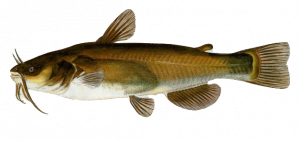In Ohio, we have bodies of water everywhere! Whether it’s coming down from the sky in buckets, or is in our streams, rivers, or Lake Erie up north, people who live here see it all the time. Have you ever wanted to know how clean the water that you come across is? The best “people” to ask are the fish that live in it! Some species of fishes are picky about the water they live in, so you only find them in water that is pretty clean. Other species can survive in water that is quite dirty! Scientists often study the types of fish they find in a body of water to help them see how clean or polluted that water is. These types of fishes are called “indicator species” because they indicate the cleanliness of the water.
The three fish pictured below are from the family Ictaluridae, which is often called the catfish family. Since catfish are so well known across Ohio, I’ve chosen three species from this family that can tell you a little bit about the quality of the water they live in. So if you find these guys in the wild, you’ll have an idea of how clean the water might be!
Species #1: Brown Bullhead Ameiurus nebulosus
This guy is definitely not a finicky fish! Brown Bullheads are good at surviving in all kinds of environments, clean or polluted. This is why scientists have classified them as a “tolerant species.” If you are only catching fish of this species, there’s a good chance that the water isn’t super clean.
Species #2: Channel Catfish Ictalurus punctatus
The Channel Catfish is a bit pickier than the Brown Bullhead, so scientists have classified this species as “intermediately tolerant.” It doesn’t need extremely clean water to survive, but it doesn’t like super polluted water either. If you catch a bunch of these catfish, the water is probably so-so in terms of cleanliness.
Species #3: Brindled Madtom Noturus miurus
This is definitely a finicky fish! Brindled Madtoms don’t survive well in polluted water at all. Scientists have classified this species as “intolerant” of pollution for this reason, and this make them a great indicator of water quality. If you find a Brindled Madtom out in the wild, there’s a good chance that the water you’re in is pretty clean!
Sources:
DNR Cornell. (n.d.). Brindled Madtom [Illustration]. Retrieved from http://www2.dnr.cornell.edu/cek7/nyfish/Ictaluridae/brindled_madtom.html
Washington Department of Fish and Wildlife. (n.d.). Brown bullhead [Illustration]. Retrieved from http://wdfw.wa.gov/fishing/washington/Species/1165/
Reece, M. (n.d.). Channel Catfish [Illustration]. Retrieved from http://www.iowadnr.gov/Fishing/Iowa-Fish-Species/Fish-Details/SpeciesCode/CCF
United States Environmental Protection Agency, National Service Center for Environmental Publications. (2008). An Introduction to Freshwater Fishes as Biological Indicators. Retrieved from https://nepis.epa.gov/Exe/ZyPDF.cgi/P1002J1W.PDF?Dockey=P1002J1W.PDF



